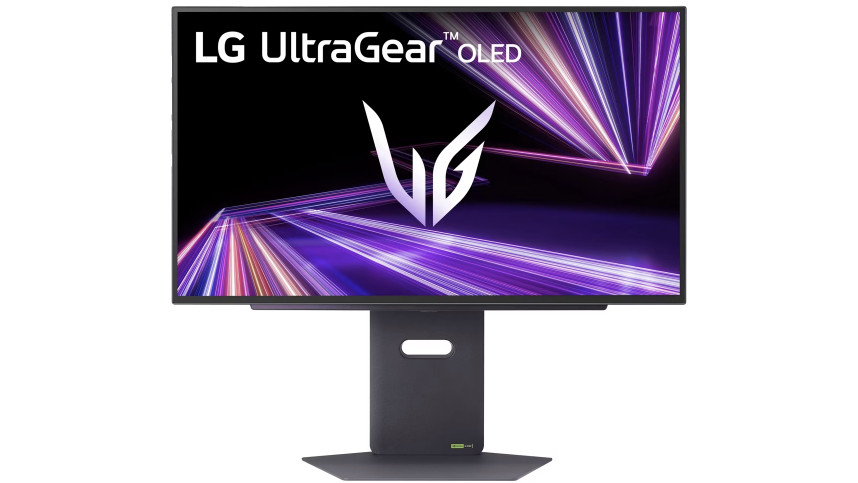What you need to know
- LG announced a 26.5-inch OLED gaming monitor with QHD resolution and 480Hz refresh rate.
- The LG UltraGear GX7 (27GX790A) includes DisplayPort 2.1, HDMI 2.1, and an ergonomic stand with VESA mounting support.
- The monitor’s WOLED panel tech boasts stellar color reproduction, VESA DisplayHDR True Black 400 certification, NVIDIA G-Sync/AMD FreeSync support, and a 0.03ms response time.
- The monitor is available now to preorder, with prices starting at $999.99.
The world of high-speed PC gaming monitors just got a bit bigger with LG’s UltraGear GX7 launch announcement. The GX7 is now available for preorder at LG’s official website for $999.99. The preorder period wraps up on December 25, 2024, and LG says the monitor is expected to start shipping on the week of December 30.
There are but a few OLED monitors that hit a sizzling 480Hz refresh rate, and the GX7 joins the likes of the Sony InZone M10S and the ASUS ROG Swift OLED PG27AQDP that launched earlier this year.
LG’s GX7 has a 26.5-inch WOLED panel with a 2560×1440 (QHD) resolution. The extra “W” in the OLED designation isn’t just for show. The company says the WOLED panel can “produce RGB colors and impressive screen brightness” thanks to a white OLED light source, and it picks up VESA DisplayHDR True Black 400 and the “highest VESA ClearMR tier” which currently sits are ClearMR 13000.
With AMD FreeSync Premium Pro support, NVIDIA G-Sync compatibility, and the latest HDMI and DisplayPort standards, it should prove to be a popular choice for enthusiast gamers who want to show off their performance hardware. And, of course, the 480Hz refresh rate and 0.03ms response time are a competitive gamer’s dream come true.
LG’s GX7 isn’t the only 480Hz OLED monitor on the market
Although LG initially announced the panel tech in the GX7 in January at CES 2024, it’s taken nearly a year for it to wind up in an LG monitor. In the meantime, Sony and ASUS have both launched similar monitors using LG’s tech.
Here’s a look at the UltraGear GX7’s specs in comparison to Sony’s InZone M10S and the ROG Swift OLED PG27AQDP.
| Header Cell – Column 0 | LG UltraGear GX7 | Sony InZone M10S | ASUS ROG Swift OLED PG27AQDP |
|---|---|---|---|
| Size | 26.5 inches | 26.5 inches | 26.5 inches |
| Panel type | WOLED | WOLED | WOLED |
| Resolution | 2560×1440 | 2560×1440 | 2560×1440 |
| Refresh rate | 480Hz | 480Hz | 480Hz |
| Response time | 0.03ms (GtG) | 0.03ms (GtG) | 0.03ms (GtG) |
| Aspect ratio | 16:9 | 16:9 | 16:9 |
| Contrast ratio | 1500000:1 | 1500000:1 | 1500000:1 |
| Brightness | 275 nits | 275 nits, 1300 nits (HDR) | 450 nits, 1300 nits (HDR) |
| Color gamut | 98.5% DCI-P3 | 98.5% DCI-P3 | 99% DCI-P3 |
| Surface treatment | Anti-glare | Anti-glare | Anti-glare |
| AMD FreeSync? | Premium Pro | No mention | Premium |
| NVIDIA G-Sync? | Compatible | Compatible | Compatible |
| VESA DisplayHDR | True Black 400 | True Black 400 | True Black 400 |
| HDR | HDR10 | HDR10 | HDR10 |
| Ports | DisplayPort 2.1, two HDMI 2.1, two USB-A 3.0 (down), USB-A 3.0 (up), 3.5mm audio | DisplayPort 2.1, two HDMI 2.1, USB-B (up), two USB-A (down), 3.5mm audio, USB-A (software updates) | DisplayPort 1.4, two HDMI 2.1, two USB-A 3.2, 3.5mm audio |
| Ergonomics | Tilt, swivel, pivot, height | Tilt, swivel, height | Tilt, swivel, pivot, height |
| Price | $999.99 | $1,099.99 | $999.99 |
It’s no surprise that the general list of specs doesn’t change much between these monitors, as all three are based on LG’s WOLED tech.
However, the ASUS monitor seems to have higher brightness when HDR isn’t enabled, but it uses an older DisplayPort 1.4 standard. The main differences between 1.4 and 2.1 standards are greatly improved bandwidth and some extra encoding efficiency, with the latter effectively offering better support for high-end graphics cards.
From a design standpoint, LG’s UltraGear GX7 seems to be a nice middle ground between Sony’s stripped-back stand and the ASUS ROG’s more aggressive forked stand. All monitors can be VESA-mounted.
Sony’s monitor is the most expensive at $1,099.99. LG and ASUS both target the $999.99 price bracket, and though they’re a bit more affordable they’re both still firmly in the premium price range.
🎃The best early Black Friday deals🦃
Do you really need a 480Hz monitor?
Dropping $1,000+ on an OLED monitor with 480Hz refresh rate isn’t a reality for most gamers. High-end monitors like the LG GX7 are reserved for enthusiasts and competitive gamers, as a higher refresh rate can certainly give you an advantage. The fact that the monitor has an OLED panel only makes it better thanks to impressive color reproduction and awesome contrast.
Monitors like the GX7 are certainly tempting, but I’d recommend most gamers check out something like the ASUS PG27AQDM OLED for around $700. It has a 1440p OLED panel with 240Hz refresh rate, 0.03ms response time, and 99% DCI-P3 color. You still get the awesome color from OLED, and the 240Hz refresh rate should be more than enough for most gamers.
The Alienware AW2725DF is also usually available for the same $700 price. It bumps the refresh rate up to 360Hz with a 1440p resolution. These are both considered to be some of the best gaming monitors on the market today, but you can save even more money on something like the Xioami G Pro monitor. It hits a 180Hz refresh rate for its mini-LED panel, and it usually costs about $370.





